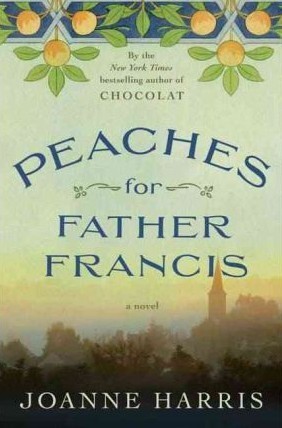- The Good: Local witch makes chocolate to save a Catholic priest
- The Bad: New Age spirituality; modern references that will date the story
- The Literary: Gorgeous prose with a strong sense of place
Vianne Rocher receives a letter from beyond the grave, asking her to return to Lansquenet because someone needs her help. She’s lived in Paris with Roux and her two daughters for almost a decade, and the return to the small town where she once owned a chocolate shop is both daunting and a welcome chance for nostalgia. But Lansquenet is not the same village she once knew thanks to the new residents, a conservative group of Muslims, women veiled in black, and a minaret across the square from Francis Raynaud’s church.
Peaches for Father Francis is the third book in the Chocolat series, but it feels like a direct sequel, since The Girl with No Shadow is set in Montmartre, Paris. Vianne and the reader return to a small town much changed, but with many of the same characters in the same circumstances, and we are left wondering if Vianne’s intrusion all those years ago actually made any difference and whether people can really change at all.
Chocolat took place during the fast of Lent and explored themes of sensuality versus abstinence. Father Reynard is the antagonist in Chocolat, but Vienne becomes his ally in this installment. In Peaches for Father Francis, Harris sets the story during Ramadan, echoing the push and pull of tradition, while exploring some of the big differences between Catholicism and Islam. Harris immediately forces the reader to reconsider the quick judgements we made in the first novel, lest we fall into our own traps of intolerance.
After all, Vianne left Roux behind in Paris because he refused to return to the small-minded town. But everyday Vianne finds another reason to stay in Lansquenet. The Muslim immigrants have opened a school in Vianne’s former chocolate shop, but it was burned out, and most believe Father Reynard to be the arsonist. The long-time residents clash with the new arrivals; factions within the Muslim community arise; even the new priest is set against Father Reynard with his modern sermons that use PowerPoint.
I especially like the treatment of the Muslim new-comers. Vianne must reconcile her own prejudices and assumptions. The different factions within their community paint a complex picture. so that they are neither the villains nor noble savages, but mostly honest people trying to do the best for the families and communities. Both Islam and Catholicism are criticized, but the priest and imam are not the villains either. Instead, it’s the ideas of purity and power that condemn.
The common thread in all of these books is good simple food. The sort of food, made with love, that brings people together on a cool evening and creates bridges across both language and cultural barriers. Vianne is a witch, and her youngest daughter especially has innate power, but Vianne is the first to admit that food is the simplest and often most effective kind of magic. In addition to the buttery sweet French delights of Chocolat, be prepared to crave aromatic and spicy Moroccan dishes with a warm cup of mint tea.
Highly recommended for fans of lyrical subtle magic, themes of acceptance and tolerance!
